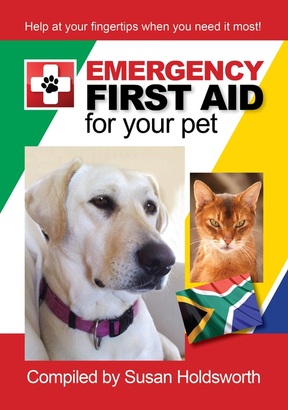|
MOTOR VEHICLE ACCIDENT
CAT/DOG HIT BY A CAR Enjoy the first in a series of Emergency First Aid articles brought to you by the author of this 'must have' book, Susan Holdsworth The content of this book has been approved by senior veterinary officials. What is really important is that pet owners know what to do in a medical emergency! If you own this book, you do not need a special first aid kit as all first aid kits (for humans) carry the necessary equipment needed. With the purchase of each book is a suggested list of contents for a first aid kit. Please remember that medicine for human use is not to be administered to dogs and cats. These INEXPENSIVE books are available via Susan's website at www.firstaidfordogs.co.za or contact her at [email protected] |
__________________________________________________
MOTOR VEHICLE ACCIDENT – CAT/DOG HIT BY A CAR
Try to move the animal out of the way of on coming traffic in order to protect both yourself and the animal from further injuries. Use a carpet from the car, a blanket, piece of cardboard, a space blanket or anything which will give him support (in the event of serious fractures) when you are trying to move him.
Assess the breathing. Is the cat/dog breathing normally or is it labored with his mouth open? A common injury is a punctured or collapsed lung (pneumothorax) causing respiratory problems. Symptoms of respiratory problems include open mouth breathing, large deep chest or stomach movements with elbows sticking out in an attempt to breathe and get air into the lungs. If there is the possibility of a fractured jaw, gently try and move his/her tongue out to one side of the mouth, to assist breathing. Bleeding from the mouth may be due to lung injury, open jaw fracture, or just a tongue injury.
Check heartbeat. A pulse can be detected by placing your fingers in the groin inside the thigh of the back legs.
Mucous Membrane Colour (Gum) . This is to detect if the animal is in shock and the potential of internal bleeding. The mucous membranes (gums) should be a healthy pink colour but if they are pale, blue or white – indication of severe shock - immediate medical attention is required.
Bleeding. Use a wad of gauze on any open wound to slow the flow of blood. Is the blood bright or dark red? This will indicate the severity of the wound. Bright red is arterial and will spurt. Dark red is venous blood and will seep or flow quickly but is easy to control. Arterial blood in an open wound indicates a serious injury. If the blood seeps through the gauze dressing, do not remove the dressing just pad extra gauze or cotton wool on top and press firmly. Do not use a tourniquet!
Fractures. Identify a fracture by the position of the limb. For an open fracture put gauze dressing on the wound and around the protruding bone. Be careful not to touch or move the bone as this will cause further pain and stress for the animal. Make a splint using a newspaper or magazine to immobilize the limb and prevent further unnecessary injury and pain.
Transport the animal to the nearest veterinary hospital.
MOTOR VEHICLE ACCIDENT – CAT/DOG HIT BY A CAR
Try to move the animal out of the way of on coming traffic in order to protect both yourself and the animal from further injuries. Use a carpet from the car, a blanket, piece of cardboard, a space blanket or anything which will give him support (in the event of serious fractures) when you are trying to move him.
Assess the breathing. Is the cat/dog breathing normally or is it labored with his mouth open? A common injury is a punctured or collapsed lung (pneumothorax) causing respiratory problems. Symptoms of respiratory problems include open mouth breathing, large deep chest or stomach movements with elbows sticking out in an attempt to breathe and get air into the lungs. If there is the possibility of a fractured jaw, gently try and move his/her tongue out to one side of the mouth, to assist breathing. Bleeding from the mouth may be due to lung injury, open jaw fracture, or just a tongue injury.
Check heartbeat. A pulse can be detected by placing your fingers in the groin inside the thigh of the back legs.
Mucous Membrane Colour (Gum) . This is to detect if the animal is in shock and the potential of internal bleeding. The mucous membranes (gums) should be a healthy pink colour but if they are pale, blue or white – indication of severe shock - immediate medical attention is required.
Bleeding. Use a wad of gauze on any open wound to slow the flow of blood. Is the blood bright or dark red? This will indicate the severity of the wound. Bright red is arterial and will spurt. Dark red is venous blood and will seep or flow quickly but is easy to control. Arterial blood in an open wound indicates a serious injury. If the blood seeps through the gauze dressing, do not remove the dressing just pad extra gauze or cotton wool on top and press firmly. Do not use a tourniquet!
Fractures. Identify a fracture by the position of the limb. For an open fracture put gauze dressing on the wound and around the protruding bone. Be careful not to touch or move the bone as this will cause further pain and stress for the animal. Make a splint using a newspaper or magazine to immobilize the limb and prevent further unnecessary injury and pain.
Transport the animal to the nearest veterinary hospital.

